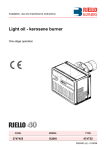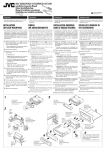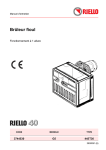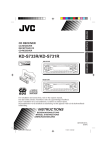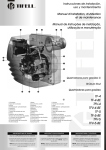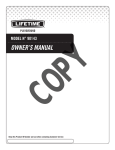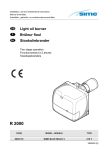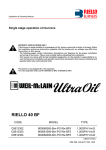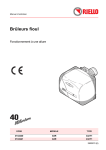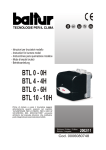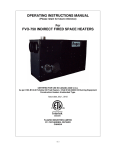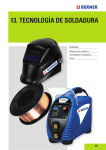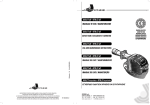Download Bruciatore a gasolio/kerosene Light oil/Kerosene Quemador
Transcript
Istruzioni per installazione, uso e manutenzione Installation, use and maintenance instructions Instrucciones de instalación, uso y mantenimiento I GB E Bruciatore a gasolio/kerosene Light oil/Kerosene Quemador de gasóleo/queroseno Funzionamento bistadio Two stage operation Funcionamiento de dos llamas CODICE CODE - CÓDIGO MODELLO MODEL - MODELO TIPO - TYPE 3748418 G20D 484T1 2903397 (2) - 06/2008 INDICE 1. 1.1 DESCRIZIONE DEL BRUCIATORE . . . . . . . . . . . . . . . . . . . . . . . . . . . . . . . . . . . . . . . . . . . . . . . 2 Materiale a corredo . . . . . . . . . . . . . . . . . . . . . . . . . . . . . . . . . . . . . . . . . . . . . . . . . . . . . . . . . . . . . . . . . 2 2. 2.1 2.2 2.3 CARATTERISTICHE TECNICHE . . . . . . . . . . . . . . . . . . . . . . . . . . . . . . . . . . . . . . . . . . . . . . . . . . Caratteristiche tecniche . . . . . . . . . . . . . . . . . . . . . . . . . . . . . . . . . . . . . . . . . . . . . . . . . . . . . . . . . . . . . . Dimensioni. . . . . . . . . . . . . . . . . . . . . . . . . . . . . . . . . . . . . . . . . . . . . . . . . . . . . . . . . . . . . . . . . . . . . . . . Campo di lavoro (secondo EN 267) . . . . . . . . . . . . . . . . . . . . . . . . . . . . . . . . . . . . . . . . . . . . . . . . . . . . 3 3 3 3 3. 3.1 3.2 3.3 3.4 3.5 INSTALLAZIONE . . . . . . . . . . . . . . . . . . . . . . . . . . . . . . . . . . . . . . . . . . . . . . . . . . . . . . . . . . . . . Fissaggio alla caldaia . . . . . . . . . . . . . . . . . . . . . . . . . . . . . . . . . . . . . . . . . . . . . . . . . . . . . . . . . . . . . . . Posizione di manutenzione . . . . . . . . . . . . . . . . . . . . . . . . . . . . . . . . . . . . . . . . . . . . . . . . . . . . . . . . . . . Impianti idraulici. . . . . . . . . . . . . . . . . . . . . . . . . . . . . . . . . . . . . . . . . . . . . . . . . . . . . . . . . . . . . . . . . . . . Collegamenti elettrici . . . . . . . . . . . . . . . . . . . . . . . . . . . . . . . . . . . . . . . . . . . . . . . . . . . . . . . . . . . . . . . . Collegamenti elettrici . . . . . . . . . . . . . . . . . . . . . . . . . . . . . . . . . . . . . . . . . . . . . . . . . . . . . . . . . . . . . . . . 4 4 4 5 6 7 4. 4.1 4.2 4.3 4.4 4.5 4.6 FUNZIONAMENTO . . . . . . . . . . . . . . . . . . . . . . . . . . . . . . . . . . . . . . . . . . . . . . . . . . . . . . . . . . . . 9 Regolazione combustione . . . . . . . . . . . . . . . . . . . . . . . . . . . . . . . . . . . . . . . . . . . . . . . . . . . . . . . . . . . . 9 Ugelli consigliati. . . . . . . . . . . . . . . . . . . . . . . . . . . . . . . . . . . . . . . . . . . . . . . . . . . . . . . . . . . . . . . . . . . . 9 Pressione pompa e portata aria . . . . . . . . . . . . . . . . . . . . . . . . . . . . . . . . . . . . . . . . . . . . . . . . . . . . . . 11 Posizionamento elettrodi . . . . . . . . . . . . . . . . . . . . . . . . . . . . . . . . . . . . . . . . . . . . . . . . . . . . . . . . . . . . 12 Programma di avviamento del bruciatore . . . . . . . . . . . . . . . . . . . . . . . . . . . . . . . . . . . . . . . . . . . . . . . 12 Electronic start delaying device . . . . . . . . . . . . . . . . . . . . . . . . . . . . . . . . . . . . . . . . . . . . . . . . . . . . . . . 13 3397 1 I 1. DESCRIZIONE DEL BRUCIATORE ³ Bruciatore in conformità alle Direttive CEE: CEM 89/336/CEE - 2004/108/CEE, Bassa Tensione 73/23/CEE 2006/95/CEE, Macchine 98/37/CEE e Rendimento 92/42/CEE. ³ Il bruciatore risponde al grado di protezione IP 40 secondo EN 60529. Fig. 1 D8078 1– 2– 3– 4– 5– 6– 7– 8– 9– 10 – 11 – Ritorno Aspirazione Attacco manometro Regolatore pressione, 2° stadio Attacco vacuometro Martinetto serranda aria 1.1 MATERIALE A CORREDO Quantità 2 1 4 1 1 1 Descrizione Tubi flessibili con nipples Flangia con schermo isolante Viti e dadi per flangia Gruppo manutenzione Vite con due dadi per flangia Passacavo 3397 2 I Vite di regolazione testa Pulsante di sblocco con segnalazione di blocco Flangia con schermo isolante Regolatore pressione, 1° stadio Ritardatore elettronico 2. CARATTERISTICHE TECNICHE 2.1 CARATTERISTICHE TECNICHE 71 / 89 ÷ 231 kW – 6 / 7,5 ÷ 19,5 kg/h 72 / 86 ÷ 219 kW – 6 / 7,2 ÷ 18,3 kg/h Potenza termica - Portata Gasolio: Kerosene: Combustibile Gasolio, viscosità max. a 20 °C: 4 ÷ 6 mm2/s (Hi = 11.86 kWh/kg) Kerosene, viscosità max. a 20 °C: 1,6 ÷ 6 mm2/s (Hi = 11.97 kWh/kg) Alimentazione elettrica Monofase, Motore 1,4A assorbiti – 2800 g/min – 293 rad/s Condensatore 5 µF Trasformatore d’accensione Secondario 8 kV – 16 mA Pompa Pressione: 7 ÷ 11 bar – 101,5 ÷ 159,5 psi Potenza elettrica assorbita 0,33 kW 230V ± 10% ~ 50Hz 2.2 DIMENSIONI Flangia 213 Bruciatore 350 118 = ø 125 11 230 45° 99 298 99 45° = 160 295 190 41 2.3 CAMPO DI LAVORO (SECONDO EN 267) D8161 Pressione in camera di combustione – mbar 4.0 3.2 2.4 1.6 0.8 0 Portata di Kerosene - kg/h 4 6 60 8 90 10 120 12 150 14 16 180 18 20 210 240 3397 3 I 22 Potenza termica - kW D5283 3. INSTALLAZIONE 3.1 FISSAGGIO ALLA CALDAIA ³ Inserire sulla flangia (1) la vite e i due dadi (vedi fig. 2). ³ Allargare, se necessario, i fori dello schermo isolante (5), (vedi fig. 3). ³ Fissare alla portina della caldaia (4) la flangia (1) mediante le viti (2) e (se necessario) i dadi (3) interponendo lo schermo isolante (5), (vedi fig. 4). 3.2 POSIZIONE DI MANUTENZIONE Accessibilità alla testa di combustione, al gruppo elica - elettrodi e all’ugello, (vedi fig. 5). ³ Estrarre il bruciatore dalla caldaia dopo avere tolto il dado di fissaggio alla flangia. ³ Agganciare il bruciatore alla flangia (1), togliere la testa di combustione (6) dopo aver allentato le viti (7). ³ Estrarre dal portaugello (8) il gruppo supporto elica (9) dopo aver allentato la vite. ³ Avvitare l’ugello (10). 4 5 Fig. 4 Fig. 2 Fig. 3 2 5 1 D5012 E9022 1 2 D8058 9 1 6 10 8 Fig. 5 7 D8056 D8057 Verificare che il bruciatore una volta installato sia leggermente inclinato verso il basso. (Vedi fig. 6). Fig. 6 Il bruciatore è predisposto per ricevere i tubi di alimentazione del combustibile da entrambi i lati. D5572 3397 4 I 3 3.3 IMPIANTI IDRAULICI ATTENZIONE: Accertarsi, prima di mettere in funzionamento il bruciatore, che il tubo di ritorno non abbia occlusioni. Un eventuale impedimento provocherebbe la rottura dell’organo di tenuta della pompa. ATTENZIONE La pompa è predisposta per funzionamento bitubo. Per il funzionamento monotubo è necessario togliere la vite di by-pass (A). (Vedi figura). L metri H metri H max. 4 m D5219 min. 0.1 m IMPIANTO NON AMMESSO IN GERMANIA 0.5 1 1.5 2 I. D. 8 mm I.D. 10 mm 10 20 40 60 20 40 80 100 A D5809 INNESCO POMPA Allentare il tappo dell’attacco vacuometro (5, fig. 1) ed attendere la fuoriuscita del combustibile. 0 0.5 1 1.5 2 3 3.5 L metri I. D. 8 mm I.D. 10 mm 35 30 25 20 15 8 6 100 100 100 90 70 30 20 Non si deve superare la depressione max. di 0,4 bar (30 cm Hg). Oltre tale valore si ha liberazione di gas dal combustibile. Si raccomanda che le tubazioni siano a perfetta tenuta. Negli impianti in depressione si consiglia di far arrivare la tubazione di ritorno alla stessa altezza della tubazione di aspirazione. In questo caso non è necessaria la valvola di fondo. Se invece la tubazione di ritorno arriva sopra il livello del combustibile la valvola di fondo è indispensabile. Questa soluzione è meno sicura della precedente per la possibile mancanza di tenuta della valvola. INNESCO POMPA Avviare il bruciatore ed attendere l’innesco. Se avviene il blocco prima dell’arrivo del combustibile, attendere 20 secondi almeno, poi ripetere l’operazione. ATTENZIONE: Q Verificare periodicamente le condizioni dei tubi flessibili. Usando il kerosene come combustibile i tubi devono essere sostituiti almeno ogni due anni. H D5220 H metri max. 4 m H H = dislivello. L = max. lunghezza del tubo di aspirazione. ø i = diametro interno del tubo. È necessario installare un filtro sulla linea di alimentazione del combustibile. 3397 5 I 3.4 COLLEGAMENTI ELETTRICI ATTENZIONE: NON SCAMBIARE IL NEUTRO CON LA FASE ATTENZIONE 230V ~ 50Hz L NOTE: – Sezione dei conduttori 1 mm2. – I collegamenti elettrici eseguiti dall’installatore devono rispettare le norme vigenti nel paese. O In caso di collegamento a caldaia senza spina a 7 poli, vedi pagina 7. N Interruttore con fusibile 6A max. Collegare il termostato 2° stadio ai morsetti T6 - T8 Neutro togliendo il ponte. h Contaore T Termostato di regolazione T Termostato di massima a riarmo manuale Caldaie con spine a 7 poli 1 Segnalazione di blocco esterna (230V - 0,5A max), a richiesta N T1 T2 S3 B4 Termostato 2° stadio T Bruciatore presa a 7 poli B5 T6 T7 T8 Giallo/ Verde C D N 2 3 Presa 4 poli E L 4 5 6 7 8 9 12 11 Morsettiera apparecchiatura 530SE C D M A ~ Motore Condensatore C D Ritardatore elettronico 4 5 6 3 2 1 2061425 (50V) B C AD Valvola 2° stadio * Valvola 1° stadio ESEGUITO IN FABBRICA 1 A Spina 4 poli D5822 A = Marrone B = Bianco C = Blu D = Nero 3397 6 I E = Grigio NOTE: Il bruciatore è provvisto di presa a 7 poli per la connessione alla spina della caldaia (vedi schema di pagina 6). Se nella caldaia non è presente suddetta spina è necessario: – Rimuovere la presa e rispettivo cablaggio montati sul bruciatore; – Eseguire la connessione elettrica diretta alla morsettiera bruciatore seguendo lo schema successivo. 3.5 COLLEGAMENTI ELETTRICI ATTENZIONE: NON SCAMBIARE IL NEUTRO CON LA FASE ATTENZIONE 230V ~ 50Hz N NOTE: – Sezione dei conduttori 1 mm2. – I collegamenti elettrici eseguiti dall’installatore devono rispettare le norme vigenti nel paese. L Collegare il termostato 2° stadio ai morsetti T6 - Interruttore con fusibile T8 togliendo il ponte. 6A max. Neutro T T Termostato di regolazione Termostato di massima a riarmo manuale 2 3 B5 T6 T7 T8 Spina 4 poli L 4 5 7 6 8 9 12 11 Morsettiera apparecchiatura 530SE C D AD B M A ~ Motore Condensatore C Ritardatore elettronico D 4 5 6 3 2 1 2061425 C Valvola 2° stadio (50V) * Valvola 1° stadio ESEGUITO IN FABBRICA 1 Termostato 2° stadio Presa 4 poli Segnalazione di blocco esterna (230V - 0,5A max), a richiesta N T D5823 A = Marrone B = Bianco C = Blu D = Nero 3397 7 I Per togliere l’apparecchiatura dal bruciatore allentare la vite (A) (vedi figura successiva) e tirare nel senso della freccia. S7348 PERCORSO DEI CAVI ELETTRICI 1 – Passacavo 2 – Fissacavo 3 – Morsettiera 4 – Morsetti per termostato 2° stadio 5 – Presa 4 poli per termostato 2° stadio 6 – Presa 7 poli per bruciatore N Trasformatore d’accensione L S7057 Fotoresistenza Neutro - Segnalazione di blocco - Fase - Terra bruciatore La fotoresistenza è montata direttamente nell’apparecchiatura (sotto il trasformatore di accensione) su un supporto ad innesto rapido. COLLAUDO Verificare l’arresto del bruciatore aprendo i termostati. 3397 8 I 4. FUNZIONAMENTO 4.1 REGOLAZIONE COMBUSTIONE In conformità con la Direttiva Rendimento 92/42/CEE, l’applicazione del bruciatore alla caldaia, la regolazione e il collaudo, devono essere eseguiti nell’osservanza del manuale d’istruzione della caldaia stessa, compreso il controllo della concentrazione di CO e CO2 nei fumi, della loro temperatura e di quella media dell’acqua della caldaia. A seconda della portata richiesta dalla caldaia vanno definiti: l’ugello, la pressione della pompa, la regolazione della testa di combustione, la regolazione della serranda, secondo la tabella seguente. Gasolio Kerosene Ugello Pressione pompa Portata bruciatore bar GPH 2.00 2.25 2.50 2.75 3.00 3.50 4.00 4.50 Angolo 60° 60° 60° 60° 60° 60° 60° 60° 1° 7* 7* 7* 7* 7* 7* 7* 7* 2° 11 11 11 11 11 11 11 11 kg/h ± 4% 1° 2° 5.90 7.27 6.37 8.02 6.90 8.62 7.50 9.56 8.56 10.64 9.35 12.0 10.50 13.15 12.24 15.32 5.00 5.50 60° 60° 7* 7* 11 10 14.35 15.27 1.75 2.00 2.25 2.50 3.00 3.50 4.00 4.50 60° 60° 60° 60° 60° 60° 60°/45° 60°/45° 9 9 9 9 9 9 9 9 14 14 14 14 14 14 14 14 6.1 7.0 7.8 8.7 10.4 12.2 13.9 15.6 Regolazione testa di combustione Regolazione serranda aria Tacca 0 (min) 1 1.5 2 2.5 3 3.5 4 1° stadio Tacca 1.9 2 2.1 2.3 2.4 2.5 2.7 2.9 2° stadio Tacca 2.3 2.5 2.6 2.9 3.1 3.3 3.8 4 17.95 18.30 5 6 (max) 4.1 4.5 8 (max) 8 (max) 7.6 8.7 9.8 10.8 13.0 15.2 17.3 19.5 1 1.5 2 2.5 3.5 4 5 6 2.3 2.5 2.7 2.9 3.2 3.5 4.5 5 2.6 3.0 3.5 3.8 4.3 5.0 6.5 8.0 *Con Kerosene il valore della pressione non deve essere superiore a 7 bar. 4.2 UGELLI CONSIGLIATI Monarch type R - PLP Delavan type B - W Steinen type S - SS Danfoss type S Gasolio Kerosene – – Angolo 60° : Nella generalità dei casi. Particolarmente adatto per evitare lo stacco di fiamma all’accensione. – : Non previsto : Applicabile REGOLAZIONE TESTA: Va fatta all’atto del montaggio dell’ugello, con boccaglio smontato. Dipende dalla portata del bruciatore e si esegue ruotando l’asta di regolazione fino a che il piano terminale del boccaglio collima con la tacca indicata in tabella. Nello schizzo a lato, la testa è regolata per una porPiano terminale boccaglio tata di 3,5 GPH a 7/11 bar. La tacca 3 dell’indicatore coincide con il piano terminale del boccaglio come indicato in tabella. 2 5 3 1 Asta di regolazione Indicatore D5284 Boccaglio 3397 9 I Le regolazioni della testa indicate in tabella vanno bene nella generalità dei casi. L’adattamento della portata del ventilatore all’impianto va fatta normalmente solo con la serranda dell’aria. Se eventualmente si vuole ritoccare successivamente, con bruciatore funzionante, anche la regolazione della testa, agire sull’asta (1) con chiave fissa (2) come segue: RUOTARE VERSO DESTRA: (segno +) Per aumentare la quantità di aria immessa in camera di combustione e diminuire la sua pressione. La CO2 diminuisce e l’aggancio fiamma al disco di turbolenza migliora. (Regolazione indicata per accensioni a basse temperature). RUOTARE VERSO SINISTRA: (segno –) Per diminuire la quantità di aria immessa in camera di combustione ed aumentare la sua pressione. La CO2 migliora e l’aggancio fiamma si riduce. (Regolazione sconsigliata per accensioni a basse temperature). Non spostare, in ogni caso, la regolazione della testa oltre una tacca dal valore indicato in tabella. Una tacca corrisponde a tre giri dell’asta. Un foro (3) alla sua estremità facilita il conto dei giri. 2 3 1 6 D8068 REGOLAZIONE SERRANDA ARIA: Le regolazioni riportate in tabella si riferiscono al bruciatore con cofano montato e camera di combustione con depressione zero. Tali regolazioni sono puramente indicative. Ogni impianto ha condizioni di funzionamento sue proprie, non prevedibili: portata effettiva dell’ugello, pressione o depressione in camera di combustione, eccesso d’aria necessario; ecc. Tutte queste condizioni possono richiedere una diversa regolazione della serranda. È importante tenere conto che la portata d’aria del ventilatore è differente a seconda che il bruciatore abbia il cofano smontato o montato. Pertanto è opportuno procedere come segue: PANNELLO ³ regolare la serranda come indicato in tabella (vedi pag. 9); ³ montare il cofano avvitando per semplicità solo la vite superiore; ³ controllare il bacharach; ³ se occorre variare la portata d’aria, allentare la vite del cofano, toglierlo, agire sulla serranda, rimontare il cofano e quindi ricontrollare il bacharach. NOTE: Quando il bruciatore lavora ad un ritmo superiore ai 18 kg/h rimuovere il pannello fissato all’interno della copertura metallica. (vedi figura) S7352 3397 10 I 4.3 PRESSIONE POMPA E PORTATA ARIA Il bruciatore è dotato di un dispositivo idraulico, comandato dal ritardatore elettronico che riduce la portata del combustibile e dell’aria al 70% circa della portata massima. Item A II - I Item B I II II - I 9 I 9 II S7353 S7354 REGOLAZIONE 1° STADIO Regolazione serranda: inserire lo spinotto (9) del ritardatore (10) nella posizione I (Item A). Allentare il dado (2) agire sulla vite (3) fino a portare la serranda (1) sulla posizione desiderata. Quindi bloccare il dado (2). Regolazione pressione: Viene tarata in fabbrica a 7 bar. Se è necessario ritarare tale pressione, o se si preferisce cambiarla, basta agire sulla vite (4). Il manometro per il controllo della pressione va montato al posto del tappo (5). REGOLAZIONE 2° STADIO Regolazione serranda: inserire lo spinotto (9) del ritardatore (10) nella posizione II (Item B). Allentare il dado (6), agire sulla vite (7) fino a portare la serranda (1), sulla posizione desiderata. Quindi bloccare il dado (6). Regolazione pressione: Viene tarata in fabbrica a 10 bar. Se è necessario ritarare tale pressione, o se si preferisce cambiarla, basta agire sulla vite (8). Il manometro per il controllo della pressione va montato al posto del tappo (5). 3397 11 I 4.4 POSIZIONAMENTO ELETTRODI ATTENZIONE: Prima di smontare o montare l’ugello allentare la vite (A) e spostare in avanti gli elettrodi. ATTENZIONE ARRETRARE IL PORTAELETTRODI FINO A BATTUTA 4 ± 0.3 mm D5288 A 6.5 ± 0.5 mm 4.5 PROGRAMMA DI AVVIAMENTO DEL BRUCIATORE Normale Con blocco per mancata accensione Termostato Motore Trasf. d’accensione Valvola Fiamma Spia blocco ~12s D5810 ~5s 3397 12 I ~12s ~5s 4.6 RITARDATORE ELETTRONICO Il ritardatore elettronico indicato in figura può essere collegato ad un termostato di 2° stadio. Quando è collegato al termostato 2° stadio svolge due funzioni: 1. Ritarda di 5 ÷ 6 secondi l’intervento della valvola del 2° stadio rispetto alla valvola del 1° stadio. 2. Seleziona il tipo di funzionamento desiderato a seconda del posizionamento dello spinotto A: S7355 A II - I I Posizione I - II = Funzionamento del bruciatore in 1° o 2° stadio su comando del termostato 2° stadio. I Posizione II = Funzionamento solo in 2° stadio, obbligatoriamente. I Posizione I = Funzionamento solo in 1° stadio, obbligatoriamente. II II - I II II - I II 3397 13 I INDEX 1. 1.1 BURNER DESCRIPTION . . . . . . . . . . . . . . . . . . . . . . . . . . . . . . . . . . . . . . . . . . . . . . . . . . . . . . . . 2 Equipment . . . . . . . . . . . . . . . . . . . . . . . . . . . . . . . . . . . . . . . . . . . . . . . . . . . . . . . . . . . . . . . . . . . 2 2. 2.1 2.2 2.3 TECHNICAL DATA . . . Technical data . . . . . . . Dimensions . . . . . . . . . Firing rate (as EN 267) . . . . . . . . . . . . . . . . . . . . . . . . . . . . . . . . . . . . . . . . .. .. .. .. .... .... .... .... ... ... ... ... .... .... .... .... ... ... ... ... .... .... .... .... ... ... ... ... .... .... .... .... ... ... ... ... .... .... .... .... ..... ..... ..... ..... . . . . . . . . . . . . . . . . . . . . . . . . . . . . . . . . 3 3 3 3 3. 3.1 3.2 3.3 3.4 3.5 INSTALLATION . . . . . Boiler fixing . . . . . . . . Maintenance position . Fuel lines . . . . . . . . . . Electrical wiring . . . . . Electrical wiring . . . . . . . . . . . . . . . . . . . . . . . . . . . . . . . . . . . . . . . . . . . . . . . . . . . . . . . . . . . . . . . . . . . . . . . . . . . . . . . . . . . . . . . . . . . . . . . . . . . . . . . . . . . . . . . . . . . . . . . . . . . . . . . . . . . . . . . . . . . . . . . . . . . . . . . . . . . . . . . . . . . . . . . . . . . . . . . . . . . . . . . . . . . . . . . . . . . . . . . . . . . . . . . . . . . . . . . . . . . . . . . . . . . . . . . . . . . . . . . . . . . . . . . . . . . . . . . . . . . . . . . .. .. .. .. .. .. . . . . . . . . . . . . . . . . . . . . . . . . . . . . . . . . . . . . 4 4 4 5 6 7 4. 4.1 4.2 4.3 4.4 4.5 4.6 WORKING . . . . . . . . . . . . . . . . Combustion adjustment . . . . . . Nozzles recommended. . . . . . . Pump pressure and air output . Electrode setting . . . . . . . . . . . Burner start-up cycle . . . . . . . . Electronic start delaying device . . . . . . . . . . . . . . . . . . . . . . . . . . . . . . . . . . . . . . . . . . . . . . . . . . . . . . . . . . . . . . . . . . . . . . . . . . . . . . . . . . . . . . . . . . . . . . . . . . . . . . . . . . . . . . . . . . . . . . . . . . . . . . . . . . . . . . . . . . . . . . . . . . . . . . . . . . . . . . . . . . . . . . . . . . . . . . . . . . . . . . . . . . . . . . . . . . . . . . . . . . . .. .. .. .. .. .. .. . . . . . . . . . . . . . . . . . . . . . . . . . . . . ... ... ... ... ... ... ... . . . . . . . ... ... ... ... ... ... ... . . . . . . . . . . . . . . . 9 . 9 . 9 11 12 12 13 . . . . . . 3397 1 GB . . . . . . . . . . . . ... ... ... ... ... ... . . . . . . ..... ..... ..... ..... ..... ..... ..... . . . . . . . 1. BURNER DESCRIPTION ³ Burner in conformity with EEC directives: EMC 89/336/EEC - 2004/108/EEC, Low Voltage 73/23/EEC - 2006/95/ EEC, Machines 98/37/EEC and Efficiency 92/42/EEC. ³ The burner meets protection level of IP X0D (IP 40), EN 60529. Fig. 1 D8078 1– 2– 3– 4– 5– 6– 7– 8– 9– 10 – 11 – Return line Suction line Gauge connection Pressure regulator, 2nd stage Vacuum gauge connection Hydraulic jacks with air-damper Combustion head adjustment screw Lock-out lamp and reset button Flange with insulating gasket Regulation pressure, 1st stage Electronic start delaying device 1.1 EQUIPMENT QUANTITY 2 1 4 1 1 1 DESCRIPTION Flexible pipes with nipples Flange with insulating gasket Screws and nuts for flange Maintenance assembly Screw with two nuts for flange 4 pin plug 3397 2 GB 2. TECHNICAL DATA 2.1 TECHNICAL DATA Thermal power – output Light oil: 71 / 89 - 231 kW – 6 / 7.5 - 19.5 kg/h Kerosene: 72 / 86 - 219 kW – 6 / 7.2 - 18.3 kg/h Light oil, max. viscosity at 20 °C: 4 ÷ 6 mm2/s (Hi = 11.86 kWh/kg) Fuel Kerosene, max. viscosity at 20 °C: 1.6 ÷ 6 mm2/s (Hi = 11.97 kWh/kg) Electrical supply Single phase, 230V ± 10% ~ 50Hz Motor Run current 1.4A – 2800 rpm – 293 rad/s Capacitor 5 µF Ignition transformer Secondary 8 kV - 16 mA Pump Pressure: 7 - 11 bar – 101.5 ÷159.5 psi Absorbed electrical power 0.33 kW 2.2 DIMENSIONS Flange Burner 350 213 ø 125 11 230 298 99 99 45° 160 190 41 2.3 FIRING RATE (AS EN 267) D8161 Pressure in the combustion chamber – mbar 4.0 3.2 2.4 1.6 0.8 0 4 6 60 295 = = 45° 118 8 90 10 120 12 150 14 16 180 18 210 240 3397 3 20 GB 22 Fuel output - kg/h Thermal power - kW D5283 3. INSTALLATION 3.1 BOILER FIXING ³ Put on the flange (1) the screw and two nuts, (see fig. 2). ³ Widen, if necessary, the insulating gasket holes (5), (see fig. 3). ³ Fix the flange (1) to the boiler door (4) using screws (2) and (if necessary) the nuts (3) interposing the insulating gasket (5), (see fig. 4). 3.2 MAINTENANCE POSITION Access to the combustion head, diffuser disc / electrodes unit and nozzle, (see fig. 5). ³ Remove the burner out of the boiler, after loosing the fixing nut to the flange. ³ Hook the burner to the flange (1), by removing the combustion head (6) after loosing the fixing screws (7). ³ Remove the diffuser disc-holder assembly (9) from the nozzle-holder (8) after loosing its fixing screw. ³ Screw the nozzle (10). 4 5 Fig. 4 Fig. 2 Fig. 3 2 5 1 D5012 E9022 1 2 D8058 9 1 6 10 8 Fig. 5 7 D8056 D8057 Verify that the installed burner is lightly leaned towards the button. (See figure 6). Fig. 6 The burner is designed to allow entry of the flexible oil-lines on either side of the burner. D5572 3397 4 GB 3 3.3 FUEL LINES WARNING: before starting the burner make sure that the return pipe-line is not clogged: any obstruction would cause the pump seals to break. WARNING The pump is supplied for use with a two pipe system. For use on a one pipe system, it is necessary to remove the by-pass screw (A), (see figure). H meters H max. 4 m D5219 min. 0.1 m SYSTEM NOT PERMITTED IN GERMANY 0.5 1 1.5 2 L meters I. D. 8 mm I.D. 10 mm 10 20 40 60 20 40 80 100 A D5809 PRIMING THE PUMP Loosen the plug of the vacuum gauge (5, fig. 1) and wait until the fuel flows out. = Difference of level. = Max. length of the suction line. I.D. = Internal diameter of the fuel pipes. D5220 H meters 0 0.5 1 1.5 2 3 3.5 L meters I. D. 8 mm I.D. 10 mm 35 30 25 20 15 8 6 100 100 100 90 70 30 20 The pump vacuum should not exceed a maximum of 0.4 bar (30 cm Hg). Beyond this limit gas is released from the fuel. Fuel lines must be completely airtight. The return line should terminate in the fuel tank at the same level as the suction line; in this case a non-return valve is not required. When the return line arrives over the fuel level, a non-return valve must be used. This solution however is less safe than previous one, due to the possibility of leakage of the valve. PRIMING THE PUMP Start the burner and wait for the priming. Should lock-out occur prior to the arrival of the fuel, await at least 20 seconds before repeating the operation. max. 4 m H H L WARNING: Q Check periodically the flexible pipes condi- tions. Using kerosene, they have to be replaced at least every 2 years. H A filter must be installed on the suction fuel line. 3397 5 GB 3.4 ELECTRICAL WIRING WARNING: DO NOT EXCHANGE THE NEUTRAL WITH THE PHASE WARNING 230V ~ 50Hz L NOTE: – Wires of 1 mm2 section. – The electrical wiring carried out by the installer must be in compliance with the rules in force in the Country. O For connection to boilers without a 7 pin plug, see page 7. Connect 2nd stage thermostat between clamps T6 and T8 removing the bridge. N Switch with fuse Neutral 6A max. h Hour counter T Regulating thermostat Limit thermostat T with manual resetting Boilers’s 7 pin plug 1 N T1 T2 S3 B4 2nd stage thermostat T Remote lock-out lamp (230V - 0.5A max.), if required Burners’s 7 pole socket B5 T6 T7 T8 Yellow/ green D 3 L 4 5 6 8 9 C D M ~ 12 11 B C AD 7 C 2nd Valve 2 4 pole socket E (50V) 1 1st Valve CARRIED-OUT IN THE FACTORY N A A Motor Capacitor D Terminal block of control-box 530SE Electronic start delaying device 4 5 6 3 2 1 2061425 C 4 pin plug D5822 A = Brown B = White C = Blue D = Black 3397 6 GB E = Grey * NOTE: The burner is provided with a 7 pole socket for the direct electrical connection to the boiler’s plug (see diagram at page 6). Should the boiler be without plug, it is then necessary: – remove the socket and respective cable mounted on the burner; – carry out the electrical connection direct to the wiring terminal block of the burner as shown on the diagram below. 3.5 ELECTRICAL WIRING WARNING: DO NOT EXCHANGE THE NEUTRAL WITH THE PHASE WARNING 230V ~ 50Hz N NOTE: – Wires of 1 mm2 section. – The electrical wiring carried out by the installer must be in compliance with the rules in force in the Country. Connect 2nd stage thermostat between clamps T6 and T8 removing the bridge. L Switch with fuse 6A max. T 2nd stage thermostat T Regulating Neutral thermostat T Limit thermostat with manual resetting B5 T6 T7 T8 4 pole socket Remote lock-out lamp (230V - 0.5A max.),if required 4 5 7 6 C C D AD 8 9 B M ~ A Motor Capacitor 12 11 C D Terminal block of control-box 530SE* Electronic start delaying device 4 5 6 3 2 1 2061425 3 2nd Valve 2 L (50V) 1 1st Valve CARRIED-OUT IN THE FACTORY N 4 pin plug D5823 A = Brown B = White C = Blue D = Black 3397 7 GB To remove the control-box from the burner, loosen screw (A) (see figure below) and pull towards the arrow. S7348 RUN OF THE ELECTRICAL CABLES 1 – Cable gland 2 – Cable-clamp 3 – Terminal block 4 – Clamps for 2nd stage thermostat 5 – 4 pole socket for 2nd stage thermostat 6 – 7 pole socket for burner N Ignition transformer S7057 Photoresistance L - Neutral - Lock-out lamp - Phase - Burner-earth The photoresistance is fitted directly into the control-box (underneath the ignition-transformer) on a plug-in support. TESTING Check the shut-down of the burner by opening the thermostats. 3397 8 GB 4. WORKING 4.1 COMBUSTION ADJUSTMENT In conformity with Efficiency Directive 92/42/EEC the application of the burner on the boiler, adjustment and testing must be carried out observing the instruction manual of the boiler, including verification of the CO and CO2 concentration in the flue gases, their temperatures and the average temperature of the water in the boiler. To suit the required appliance output, fit the nozzle, the settings of the combustion head and the air damper opening in accordance with the following schedule. Light oil Kerosene Nozzle GPH 2.00 2.25 2.50 2.75 3.00 3.50 4.00 4.50 5.00 5.50 Angle 60° 60° 60° 60° 60° 60° 60° 60° 60° 60° 1.75 2.00 2.25 2.50 3.00 3.50 4.00 4.50 60° 60° 60° 60° 60° 60° 60°/45° 60°/45° Pump pressure bar 1st 2nd 7* 11 7* 11 7* 11 7* 11 7* 11 7* 11 7* 11 7* 11 7* 11 7* 10 9 9 9 9 9 9 9 9 14 14 14 14 14 14 14 14 Burner output kg/h ± 4% 1st 2nd 5.90 7.27 6.37 8.02 6.90 8.62 7.50 9.56 8.56 10.64 9.35 12.0 10.50 13.15 12.24 15.32 14.35 17.95 15.27 18.30 6.1 7.0 7.8 8.7 10.4 12.2 13.9 15.6 Combustion head adjustment 7.6 8.7 9.8 10.8 13.0 15.2 17.3 19.5 Air damper adjustment Set-point 0 (min) 1 1.5 2 2.5 3 3.5 4 5 6 (max) 1st stage Set-point 1.9 2 2.1 2.3 2.4 2.5 2.7 2.9 4.1 4.5 2nd stage Set-point 2.3 2.5 2.6 2.9 3.1 3.3 3.8 4 8 (max) 8 (max) 1 1.5 2 2.5 3.5 4 5 6 2.3 2.5 2.7 2.9 3.2 3.5 4.5 5 2.6 3.0 3.5 3.8 4.3 5.0 6.5 8.0 *With Kerosene, the pressure value in the 1st stage must be no greater than 7 bar. 4.2 NOZZLES RECOMMENDED Monarch type R - PLP Delavan type B - W Steinen type S - SS Danfoss type S Light oil Kerosene – – Angle 60° : in most cases. Particularly suited to avoid flamedetachment during ignition. – : Not foreseen : Applicable COMBUSTION HEAD SETTING: This is done when fitting the nozzle, with the blast tube removed. It depends on the output of the burner and is carried out by rotating the regulating rod, till the terminal plane of the blast tube is level with the set-point, as indicated in the schedule. In the sketch on the left, the combustion head is set for an Terminal plane of the blast tube output of 3.5 GPH at 7/11 bar, while the shutter is level with set-point 3, as required by the above schedule. 2 5 3 1 Regulating rod Shutter D5284 Blast tube 3397 9 GB Combustion head settings indicated in the schedule are valid for most cases. The setting of the fan output according to the installation should normally be done only through the air damper. Should one subsequently want to retouch also the setting of the combustion head, with the burner running, operate on the rod (1) with a 6 mm spanner (2) as follows: Turn to the right: (sign +), in order to increase the volume of air entering the combustion chamber and thus diminishing its pressure. There is a reduction of CO2 and the adhesion of the flame to the air diffuser disc improves. (Setting advisable for ignitions at low temperatures). Turn to the left: (sign –), in order to reduce the volume of air entering the combustion chamber and thus increasing its pressure. The CO2 improves and the adhesion of the flame to the diffuser tends to reduce. (This setting is not advisable for ignitions at low temperatures). In any case do not bring the combustion head setting more than one point away from that indicated in the schedule. One setpoint corresponds to 3 turns of the rod; a hole (3) at its end facilitates counting the number of turns. 2 3 1 6 D8068 AIR DAMPER ADJUSTMENT: The settings indicated in the schedule refer to the burner with its metal cover fitted and the combustion chamber with “zero” depression. These regulations are purely indicative. Each installation however, has its own unpredictable working conditions: actual nozzle output; positive or negative pressure in the combustion-chamber, the need of excess air, etc. All these conditions may require a different airdamper setting. It is important to take account of the fact that the air output of the fan differs according to whether the burner has its metal cover fitted or not. Therefore we recommended to proceed as follows: PANEL ³ adjust the air damper as indicated in the schedule (see page 9); ³ mount the cover, simply by means of the upper screw; ³ check smoke number; ³ should it become necessary to modify the air output, remove the cover by loosening the screw, adjust the air damper, remount the cover and finally recheck the smoke number. NOTE: When the burner works at a firing rate higher than 18 kg/h remove the panel fitted inside the metal cover. (See figure). S7352 3397 10 GB 4.3 PUMP PRESSURE AND AIR OUTPUT The burner is provided with an hydraulic device controlled by the electronic start delaying device which reduces to approx. 70% the max. output of fuel and air. Item A II - I Item B I II 9 II - I I 9 II S7353 S7354 1st STAGE ADJUSTMENT Adjustment of air shutter: place the small plug (9) of the electronic start delaying device (10) into the position I (Item A). In this way the burner will remain permanently in the 1st stage. Unloosen the nut (2), turn the screw (3) until the air shutter (1) reaches the position desired. Then lock the nut (2). Pressure regulation: this is set at 7 bar at the factory. Should such pressure be reset or changed, just turn the screw (4). The pressure gauge must be mounted in place of cap (5). 2nd STAGE ADJUSTMENT Adjustment of air shutter: place the small plug (9) of the electronic start delaying device (10) into the position II (Item B). In this way the burner remains permanently in the 2nd stage. Unloosen the nut (6), turn the screw (7) until the air shutter (1) reaches the position desired. Then lock the nut (6). Pressure regulation: this is set at 10 bar at the factory. Should such pressure be reset or changed, just turn the screw (8). The pressure gauge must be mounted in place of cap (5). 3397 11 GB 4.4 ELECTRODE SETTING WARNING: Before assembling or removing the nozzle, loosen the screw (A) and move the electrodes ahead. WARNING MOVE THE ELECTRODE HOLDER BACKWARDS TO THE END 4 ± 0.3 mm D5288 A 6.5 ± 0.5 mm 4.5 BURNER START-UP CYCLE Normal Lock-out, due to light-failure Thermostat Motor Ignition transformer 1st stage valve 2nd stage valve Lock-out lamp ~12s ~5s D5810 3397 12 GB ~12s ~5s 4.6 ELECTRONIC START DELAYING DEVICE This electronic start delaying device showed in fig. on the right can be wired to a 2nd stage thermostat; in this case it performs two functions: 1. Delay of 5 - 6 seconds in the intervention of the 2nd stage valve against 1st stage valve. 2. In relation of the position of the plug A, it determines the type of required operation: S7355 A II - I I Position I - II = Burner operation in 1 st or 2nd stage on request of the 2nd stage thermostat. I Position II = Burner operation only in 2nd stage - compulsorily. I Position I = Burner operation only in 1st stage - compulsorily. II II - I II II - I II 3397 13 GB ÍNDICE 1. 1.1 DESCRICIÓN QUEMADOR . . . . . . . . . . . . . . . . . . . . . . . . . . . . . . . . . . . . . . . . . . . . . . . . . . . . . . 2 Equipamiento . . . . . . . . . . . . . . . . . . . . . . . . . . . . . . . . . . . . . . . . . . . . . . . . . . . . . . . . . . . . . . . . . 2 2. 2.1 2.2 2.3 CARACTERÍSTICAS TÉCNICAS . Características técnicas . . . . . . . . . Dimensiones . . . . . . . . . . . . . . . . . Campo de trabajo (según EN 267) . . . . . . . . . . . . . . . . . . . . . . . . . . . . . . . . . . . . . . . . . . . . . . . . . . . . . . . . . . . . . . . . . . . . . . . . . . . . . . . . . . . . . . . . . . . . . . . . . . . . . . . . . . . . . . . . . . . . . . . . . . . . . . . . . . . . . . . . . . . . . . . . . . . . . . . . . . . . . . . . . . . . . . . . . . . . . . . . . . . . . . . . . . . . . . . . . 3 3 3 3 3. 3.1 3.2 3.3 3.4 3.5 INSTALACIÓN. . . . . . . . . . Fijación a la caldera . . . . . . Posición de mantenimiento Instalación hidráulica . . . . . Cableado eléctrico . . . . . . . Conexión eléctrica . . . . . . . . . . . . . . . . . . . . . . . . . . . . . . . . . . . . . . . . . . . . . . . . . . . . . . . . . . . . . . . . . . . . . . . . . . . . . . . . . . . . . . . . . . . . . . . . . . . . . . . . . . . . . . . . . . . . . . . . . . . . . . . . . . . . . . . . . . . . . . . . . . . . . . . . . . . . . . . . . . . . . . . . . . . . . . . . . . . . . . . . . . . . . . . . . . . . . . . . . . . . . . . . . . . . . . . . . . . . . . . . . . . . . . . . . . . . . . . . . . . . . . . . . . . . . . . . . . . . . . . . . . . . . . . . . . . . . . . . . . . . . . . . . . . . . . . 4 4 4 5 6 7 4. 4.1 4.2 4.3 4.4 4.5 4.6 FUNCIONAMIENTO . . . . . . . . . . . . . Regulación de la combustión . . . . . . . Boquillas recomendadas . . . . . . . . . . Presión de la bomba y caudal de aire Regulación electrodos . . . . . . . . . . . . Programa de puesta en marcha . . . . . Retardador electrónico . . . . . . . . . . . . . . . . . . . . . . . . . . . . . . . . . . . . . . . . . . . . . . . . . . . . . . . . . . . . . . . . . . . . . . . . . . . . . . . . . . . . . . . . . . . . . . . . . . . . . . . . . . . . . . . . . . . . . . . . . . . . . . . . . . . . . . . . . . . . . . . . . . . . . . . . . . . . . . . . . . . . . . . . . . . . . ... ... ... ... ... ... ... . . . . . . . . . . . . . . . . . . . . . .... .... .... .... .... .... .... .... .... .... .... .... .... .... . . . . . . . . 9 . 9 . 9 11 12 12 13 . . . . . . . . . . . . . . . . . . . . . . . . . . . . . . . . . . . . 3397 1 E ....... ....... ....... ....... ....... ....... ....... 1. DESCRICIÓN QUEMADOR ³ Quemador conforme a las Directivas CEE: EMC 89/336/CEE - 2004/108/CEE, 73/23/CEE - 2006/95/CEE de Bajo Voltaje, 98/37/CEE de Máquinas y 92/42/CEE de Rendimientos. ³ El quemador tiene un nivel de protección IP X0D (IP 40), según EN 60529. Fig. 1 D8078 1– 2– 3– 4– 5– 6– 7– 8– 9– 10 – 11 – Tubo de retorno Tubo de aspiración Racor del manómetro Regulador de presión, 2ª llama Racor del vacuómetro Tomas hidráulicas con registro del aire 1.1 EQUIPAMIENTO CANTIDAD DESCRIPCIÓN 2 1 4 1 1 1 Tubos flexibles con racores Brida con junta aislante Tornillos y tuercas para la brida Conjunto mantenimiento Tornillo con dos tuercas para la brida Conector macho de 4 contactos 3397 2 E Tornillo de regulación del cabezal de combustión Indicador de bloqueo y botón de reset Brida con junta aislante Presión de regulación, 1ª llama Retardador electrónico 2. CARACTERÍSTICAS TÉCNICAS 2.1 CARACTERÍSTICAS TÉCNICAS Capacidad - Rendimiento térmico Gasóleo: 71 / 89 - 231 kW – 6 / 7.5 - 19.5 kg/h Queroseno:72 / 86 - 219 kW – 6 / 7.2 - 18.3 kg/h Combustible Gasóleo, viscosidad máx. a 20 °C: 4 ÷ 6 mm2/s (Hi = 11.86 kWh/kg) Queroseno, viscosidad máx. a 20 °C: 1.6 ÷ 6 mm2/s (Hi = 11.97 kWh/kg) Alimentación eléctrica Monofásica, Motor Corriente absorbida 1.4A – 2800 rpm – 293 rad/s Capacitor 5 µF Transformador de encendido Secundario 8 kV – 16 mA Presión de la bomba: 7 - 11 bar – 101.5 ÷159.5 psi Potencia eléctrica absorbida 0.33 kW 230V ± 10% ~ 50Hz 2.2 DIMENSIONES Brida Quemador 350 213 118 ø 125 = 11 160 230 45° 99 298 99 45° = 190 41 2.3 CAMPO DE TRABAJO (SEGÚN EN 267) D8161 Presión en la cámara de combustión - mbar 4.0 3.2 2.4 1.6 0.8 0 4 6 60 295 8 90 10 120 12 150 14 16 180 18 20 210 240 3397 3 E 22 Rendimiento del Queroseno - kg/h Potencia térmica - kW D5283 3. INSTALACIÓN 3.1 FIJACIÓN A LA CALDERA ³ Introduzca en la brida (1) el tornillo y las dos tuercas, (ver fig. 2). ³ Ensanche, si es necesario, los agujeros de la protección aislante (5), (ver fig. 3). ³ Fije a la portezuela de la caldera (4) la brida (1) mediante los tornillos (2) y (si es necesario) las tuercas (3) interponiendo la protección aislante (5), (ver Fig. 4). 3.2 POSICIÓN DE MANTENIMIENTO Accesibilidad al cabezal de combustión, al grupo disco estabilizador - electrodos y a la boquilla, (ver Fig. 5). ³ Retirar el quemador de la caldera luego de haber quitado la tuerca de fijación a la brida. ³ Enganchar el quemador a la brida (1), sacar el cabezal de combustión (6) luego de haber aflojado los tornillos (7). ³ Extraer del portaboquilla (8) el grupo soporte del disco estabilizador (9) luego de haber aflojado el tornillo. ³ Enroscar la boquilla (10). 4 5 Fig. 4 Fig. 2 Fig. 3 2 5 1 D5012 E9022 1 2 D8058 9 1 6 10 8 Fig. 5 7 D8056 D8057 Compruebe que una vez instalado el quemador quede ligeramente inclinado hacia abajo. (Ver fig. 6). Fig. 6 Es posible conectar los tubos de alimentación del gasóleo a ambos lados del quemador. D5572 3397 4 E 3 3.3 INSTALACIÓN HIDRÁULICA ATENCIÓN: antes de poner en marcha el quemador asegúrese que el tubo de retorno no esté obstruido: las obstrucciones pudieran causar la rotura de los órganos de estanqueidad de la bomba. ATENCIÓN La bomba está prevista para trabajar en bitubo. Para el funcionamiento en monotubo, se debequitar el tornillo de by-pass (A), (ver la figura). H metros H max. 4 m D5219 min. 0.1 m SISTEMA NO PERMITIDO EN ALEMANIA 0.5 1 1.5 2 L metros I. D. 8 mm I.D. 10 mm 10 20 40 60 20 40 80 100 A D5809 CEBADO DE LA BOMBA Aflojar el racor del vacuómetro (5, fig. 1, página 1) y hasta que salga combustible. = Diferencia de nivel. = Máx. longitud del tubo de H L D5220 max. 4 m H aspiración. I.D. = Diámetro interno del tubo de alimentación de combustible. H metros 0 0.5 1 1.5 2 3 3.5 L metros I. D. 8 mm I.D. 10 mm 35 30 25 20 15 8 6 100 100 100 90 70 30 20 No hay que sobrepasar la depresión máxima de 0.4 bar (30 cm Hg). Si se supera dicho límite, el gasóleo libera humos. Por encima de este valor se produce la gasificación del combustible. La tubería de retorno debe llegar a la misma altura de la de aspiración; en este caso no se necesita una válvula antirretorno. Cuando la tubería de retorno llega por arriba del nivel de combustible, se debe utilizar una válvula antirretorno. Sin embargo, esta solución es menos segura que la anterior, debido a la eventual falta de estanqueidad de la válvula. CEBADO DE LA BOMBA Arrancar el quemador y esperar el cebado. Si el bloqueo del quemador se produce antes de la llegada del combustible, esperar como mínimo 20 segundos e iniciar de nuevo esta operación. H ATENCIÓN: Q Verificar periódicamente las condiciones de los tubos flexibles. Usando el queroseno, tienen que ser substituidos por lo menos cada dos anos. Se debe instalar un filtro en el tubo de aspiración de combustible. 3397 5 E 3.4 CABLEADO ELÉCTRICO ATENCIÓN: NO INVERTIR EL NEUTRO CON LA FASE ATENCIÓN 230V ~ 50Hz L NOTAS: – Cables de 1 mm2 de sección. – Las conexiones eléctricas efectuadas por el instalador deben cumplir la normativa vigente en el país. O Para la conexión a las calderas sin un conector macho de 7 contactos, ver la página 5. Conectar el termostato de 2ª llama entre las abrazaderas T6 y T8, eliminando el puente. N Interruptor con fusible Neutro 6A máx. h Cuentahoras T Regulación del termostato T Termostato de regulación con reinicio manual 1 Indicador de bloqueo remoto (230V - 0.5A máx.), si se requiere N T1 T2 S3 B4 2ª llama termostato T Conector hembra de 7 contactos B5 T6 T7 T8 Amarillo/ verde C D N 3 L 4 5 6 8 9 C 2ª Válvula M ~ 12 11 B C D AD 7 (50V) 2 Conector hembra de 4 contactos E C 1ª Válvula SE REALIZA EN LA FÁBRICA 1 A Conector macho de 4 contactos A Motor Capacitor D Bloque de terminales de la caja de control 530SE* Retardador electrónico 4 5 6 3 2 1 2061425 Conector macho de 7 contactos D5822 A = Marrón B = Blanco C = Azul D = Negro 3397 6 E E = Gris NOTAS: El quemador se suministra con un conector hembra de 7 contactos para la conexión eléctrica directa con el conector macho de la caldera (ver el diagrama en la página 4). Si la caldera no tiene un conector macho, es necesario: – quitar el conector hembra y el cable montado en el quemador; – realizar la conexión eléctrica directa al bloque de terminales de cableado del quemador como se muestra en el diagrama de abajo. 3.5 CONEXIÓN ELÉCTRICA ATENCIÓN: NO INVERTIR EL NEUTRO CON LA FASE ATENCIÓN 230V ~ 50Hz N NOTAS: – Cables de 1 mm2 de sección. – Las conexiones eléctricas efectuadas por el instalador deben cumplir la normativa vigente en el país. Conectar el termostato de 2ª llama entre las abrazaderas T6 y T8, eliminando el puente. L Interruptor con fusible 6A máx. 2ª llama termostato T Regulación del T termostato Neutro Termostato T de regulación con reinicio manual B5 T6 T7 T8 Conector hembra de 4 contactos Indicador de bloqueo remoto (230V - 0.5A máx.), si se requiere 4 5 C C D AD 7 6 8 9 B M ~ A Motor Capacitor 12 11 C D Bloque de terminales de la caja de control 530SE* Retardador electrónico 4 5 6 3 2 1 2061425 3 2ª Válvula 2 L (50V) 1 1ª Válvula SE REALIZA EN LA FÁBRICA N Conector macho de 4 contactos D5823 A = Marrón B = Blanco C = Azul D = Negro 3397 7 E Para quitar la caja de control del quemador, destornillar el tornillo (A) (ver la figura de abajo) y extraer la flecha. S7348 DISPOSICIÓN DE LOS CABLES ELÉCTRICOS 1 – Prensacables 2 – Abrazadera de cables 3 – Bloque de terminales 4 – Abrazaderas para termostato de 2ªllama 5 – Conector hembra de 4 contactos para termostato de 2ª llama termostato 6 – Conector hembra de 7 contactos para quemador N Transformador de encendido - Neutro - Indicador de bloqueo L - Fase - Quemador-tierra S7057 Fotorresistencia La fotorresistencia se instala directamente en la caja de control (debajo del transformador de encendido) en el soporte de enchufe. PRUEBA Compruebe el apagado del quemador abriendo los termostatos. 3397 8 E 4. FUNCIONAMIENTO 4.1 REGULACIÓN DE LA COMBUSTIÓN Conforme a la Directiva de Rendimiento 92/42/CEE, seguir las indicaciones del manual de la caldera para montar el quemador, efectuar la regulación y probar verificando la concentración de CO y CO2, en los humos, su temperatura y la media del agua de la caldera. Según el caudal de combustible exigido por la caldera se debe determinar la boquilla, la presión de la bomba, la regulación del cabezal de combustión y la regulación del registro del aire, ver las tablas que siguen. Gasóleo Queroseno Boquilla GPH 2.00 2.25 2.50 2.75 3.00 3.50 4.00 4.50 5.00 5.50 Angle 60° 60° 60° 60° 60° 60° 60° 60° 60° 60° 1.75 2.00 2.25 2.50 3.00 3.50 4.00 4.50 60° 60° 60° 60° 60° 60° 60°/45° 60°/45° Presión de la bomba bar 1a 2a 7* 11 7* 11 7* 11 7* 11 7* 11 7* 11 7* 11 7* 11 7* 11 7* 10 9 9 9 9 9 9 9 9 14 14 14 14 14 14 14 14 Caudal del quemador kg/h ± 4% 1a 2a 5.90 7.27 6.37 8.02 6.90 8.62 7.50 9.56 8.56 10.64 9.35 12.0 10.50 13.15 12.24 15.32 14.35 17.95 15.27 18.30 6.1 7.0 7.8 8.7 10.4 12.2 13.9 15.6 Regulación del cabezal de combustión Regulación del registro del aire Punto de ajuste 0 (mín) 1 1.5 2 2.5 3 3.5 4 5 6 (máx) 1a llama Punto de ajuste 1.9 2 2.1 2.3 2.4 2.5 2.7 2.9 4.1 4.5 2a llama Punto de ajuste 2.3 2.5 2.6 2.9 3.1 3.3 3.8 4 8 (máx) 8 (máx) 1 1.5 2 2.5 3.5 4 5 6 2.3 2.5 2.7 2.9 3.2 3.5 4.5 5 2.6 3.0 3.5 3.8 4.3 5.0 6.5 8.0 7.6 8.7 9.8 10.8 13.0 15.2 17.3 19.5 * Con funcionamiento a queroseno, el valor de la presión en 1a llama no debe superar los 7 bar. 4.2 BOQUILLAS RECOMENDADAS Monarch type R - PLP Delavan type B - W Steinen type S - SS Danfoss type S Gasóleo Queroseno – – Ángulo 60° : en la mayoría de los casos. Se usa preferentemente para evitar que falle la llama durante el encendido. – : No previsto : Aplicable REGULACIÓN DEL CABEZAL DE COMBUSTIÓN: Se realiza cuando se coloca la boquilla, con el tubo de ventilación quitado. Depende de la capacidad del quemador y se lleva a cabo girando la varilla de regulación hasta que el plano terminal del tubo de ventilación esté a nivel con el punto de ajuste, como se indica en la tabla. En el diagrama de la izquierda, el cabezal de comPlano terminal del tubo de ventilación bustión se regula para un caudal de 3.5 GPH a 7/11 bar, y el obturador está a nivel con el punto de ajuste 3, como se indica en la tabla de arriba. 2 5 3 1 Varilla de regulación Obturador D5284 Tubo de ventilación 3397 9 E Los ajustes del cabezal de combustión de la tabla son válidos en la mayoría de los casos. El ajuste de la salida del ventilador de acuerdo con la instalación se debe realizar normalmente a través del registro de aire. Si se desea volver a ajustar posteriormente esta versión de combustión con el quemador trabajando, accionar la varilla (1) con una llave de 6 mm (2) como sigue: GIRO HACIA LA DERECHA: (signo +) Para aumentar el volumen de aire que entra en la cámara de combustión y así disminuir la presión. Hay una reducción de CO2 y la adherencia de la llama al disco de difusión de aire aumenta. (Este ajuste se recomienda para los encendidos a bajas temperaturas). GIRO HACIA LA IZQUIERDA: (signo -) Para reducir el volumen de aire que entra en la cámara de combustión y así aumentar su presión. El CO2 aumenta y la adherencia de la llama al difusor tiende a reducirse. (Este ajuste no se recomienda para los encendidos a bajas temperaturas). En cualquier caso, no mueva el ajuste del cabezal de combustión más allá del punto indicado en la tabla. Un punto de ajuste corresponde a 3 giros de la varilla; un hueco (3) al final facilita el conteo del número de giros. 2 3 1 6 D8068 REGULACIÓN DEL REGISTRO DEL AIRE: El ajuste indicado en la tabla se refiere al quemador con su tapa de metal puesta y la cámara de combustión con depresión "cero". Estas regulaciones son solamente indicativas. Sin embargo, cada instalación tiene condiciones de trabajo impredecibles: caudal real de las boquillas; presión positiva o negativa en la cámara de combustión, necesidad de exceso de aire, etc. Todas estas condiciones pudieran requerir un ajuste diferente del registro de aire. Es importante tener en cuenta que la salida de aire del ventilador varía si el quemador tiene la tapa de metal puesta o no. Por lo tanto recomendamos proceder como sigue: PANEL ³ ajustar el registro del aire como se indica en la tabla (Ver pág. 9); ³ montar la tapa, simplemente colocando los tornillos de arriba; ³ comprobar el número de humos; ³ si fuera necesario modificar el caudal de aire, quitar la tapa aflojando los tornillos, ajustar el registro de aire, volver a montar la tapa y volver a comprobar el número de humos. NOTAS: Cuando el quemador trabaja a un régimen de encendido superior a 18 kg/h quitar el panel colocado dentro de la tapa de metal. (Ver la figura). S7352 3397 10 E 4.3 PRESIÓN DE LA BOMBA Y CAUDAL DE AIRE El quemador se suministra con un dispositivo hidráulico controlado por un retardador electrónico que reduce a aproximadamente 70% el caudal máximo de gasóleo y aire. Elemento A II - I Elemento B I II II - I 9 I 9 II S7353 S7354 1ª LLAMA - REGULACIÓN Regulación del obturador de aire: coloque la clavija pequeña (9) del retardador electrónico (10) en la posición (Elemento A). Así el quemador permanecerá permanentemente en la 1ª llama. Apretar la tuerca (2), gire el tornillo (3) hasta que el obturador de aire (1) llegue a la posición deseada. Luego, bloquee la tuerca (2). I Regulación de presión: se realiza a 8 bar en la fábrica. Si la presión se debe reiniciar o cambiar, girar el tornillo (4). El manómetro se debe montar en lugar de la tapa (5). 2ª LLAMA - REGULACIÓN Regulación del obturador de aire: coloque la clavija pequeña (9) del retardador electrónico (10) en la posición II (Elemento B). Así el quemador permanecerá permanentemente en la 2ª llama. Apretar la tuerca (6), gire el tornillo (7) hasta que el obturador de aire (1) llegue a la posición deseada. Luego, bloquee la tuerca (6). Regulación de presión: se realiza a 14 bar en la fábrica. Si la presión se debe reiniciar o cambiar, girar el tornillo (8). El manómetro se debe montar en lugar de la tapa (5). 3397 11 E 4.4 REGULACIÓN ELECTRODOS ATENCIÓN: Antes de ensamblar o quitar la boquilla, aflojar el tornillo (A) y mover hacia adelante los electrodos. ATENCIÓN MOVER EL PORTAELECTRODO HACIA ATRÁS HASTA EL FINAL 4 ± 0.3 mm D5288 A 6.5 ± 0.5 mm 4.5 PROGRAMA DE PUESTA EN MARCHA Bloqueo, debido a un pequeño fallo Normal Termostato Motor Transf. de encendido 1 válvula de 1ª llama 2 válvula de 2ª llama Indicador de bloqueo ~12s D5810 ~5s 3397 12 E ~12s ~5s 4.6 RETARDADOR ELECTRÓNICO El retardador electrónico mostrado en la figura de la derecha se puede conectar al termostato de 2ª llama. El economizador, conectado al termostato de 2ª llama realiza dos funciones: 1. Retardo de 5 - 6 segundos en la activación de la válvula de 2ª llama en relación con la válvula de 1ª llama. 2. En relación con la posición de la clavija A, determina el tipo de operación requerida: S7355 A II - I I Posición I - II = Operación del quemador en 1ª o 2ª llama solicitada por la 2ª llama del termostato. II II - I I Posición II = Operación del quemador solamente en 2ª llama obligatoriamente. I Posición I = Operación del quemador solamente en 1ª llama obligatoriamente. II II - I II 3397 13 E RIELLO S.p.A. I-37045 Legnago (VR) Tel.: +39.0442.630111 http:// www.riello.it http:// www.rielloburners.com Con riserva di modifiche - Subject to modifications - Con la posibilidad de modificaciones














































